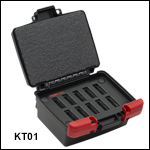Absorptive and Reflective Neutral Density Filter Kits

- Reflective and Absorptive ND Kits
- Laser-Engraved Labels on Mounted Versions
- Choose from Ø1/2", Ø25 mm, Ø2", and 2"x 2" Sizes
NEK01S

Please Wait
| Neutral Density Filter Selection Guide |
|
|---|---|
| Absorptive | |
| Uncoated (400 - 650 nm) |
Mounted |
| Unmounted | |
| Uncoated (1000 - 2600 nm) |
Mounted |
| Unmounted | |
| AR Coated (350 - 700 nm) |
Mounted |
| Unmounted | |
| AR Coated (650 - 1050 nm) |
Mounted |
| Unmounted | |
| AR Coated (1050 - 1700 nm) |
Mounted |
| Unmounted | |
| Variable | |
| Reflective | |
| UV Fused Silica (200 - 1200 nm) |
Mounted |
| Unmounted | |
| N-BK7 (350 - 1100 nm) |
Mounted |
| Unmounted | |
| ZnSe (2 - 16 µm) |
Mounted |
| Unmounted | |
| Wedged UVFS (200 - 1200 nm) | |
| Wedged N-BK7 (350 - 1100 nm) | |
| Variable | |
| Neutral Density Filter Kits | |
Features
- Ø1" Mounted Reflective (Metallic) ND Filters Available
- Ø1/2", Ø25 mm, Ø2", or 2" x 2" Absorptive ND Filters Available
- 10 Filters Included with Optical Densities from 0.1 - 4.0 (12 Filters from 0.1 - 5.0 for the NEK02)
- Mounted Versions are Housed in Labeled SM Threaded Lens Tubes
- Labeled Inserts Hold Filters Securely in Storage Box
Thorlabs' Reflective and Absorptive Neutral Density (ND) Filter Kits offer our most popular filters prepackaged in convenient metal storage boxes. Refer to the Specs (Reflective) and Specs (Absorptive) tabs above for detailed information about the filters included with each kit.
The Ø1/2" Absorptive ND Filters are mounted in SM05 series lens tubes, the Ø25 mm Metallic and Absorptive ND Filters are mounted in SM1 series lens tubes, and the Ø2" absorptive ND filters are mounted in SM2 series lens tubes. In all cases the housing is engraved with the optical density. Same-size lens tubes are stackable, making it possible to create an additive optical density effect. The Absorptive 2" Square Filters can be mounted in our stackable filter holders, also making it possible to create an additive optical density effect.
Each set of filters is housed in a metal box for convenient storage and transportation. Additional storage boxes designed to house mounted Ø25 mm filters (KT01), mounted Ø2" filters (KT06), or unmounted 2" square filters (KT03) can be purchased separately.
Optical Density and Transmission
Optical density (OD) indicates the attenuation factor provided by an optical filter, i.e. how much it reduces the optical power of an incident beam. OD is related to the transmission, T, by the equation

where T is a value between 0 and 1. Choosing an ND filter with a higher optical density will translate to lower transmission and greater absorption of the incident light. For higher transmission and less absorption, a lower optical density would be appropriate. As an example, if a filter with an OD of 2 results in a transmission value of 0.01, this means the filter attenuates the beam to 1% of the incident power. Please note that the transmission data for our neutral density filters is provided in percent (%).
Please note that these products are not designed for use as laser safety equipment. For lab safety, Thorlabs offers an extensive line of safety and blackout products, including beam blocks, that significantly reduce exposure to stray light.
Reflective ND Filters
| NDK01 Kit - Common Specifications | |
|---|---|
| Substrate | N-BK7a |
| Front Surface Coating | Inconel |
| Spectral Range | 350 - 1100 nm |
| Unmounted Optic Diameter | Ø25.0 +0.00/-0.20 mm |
| Unmounted Optic Thickness | 1.0 ± 0.10 mm (unmounted) |
| Clear Aperture | 90% of Optic Diameter |
| Surface Quality | 40-20 Scratch-Dig |
| Surface Flatness | <2λ |
| Parallelism | <3 arcsec |
| Damage Threshold | See Damage Thresholds Tab |
UV Reflective ND Filters
| NUK01 Kit - Common Specifications | |
|---|---|
| Substrate | UV Fused Silicaa |
| Front Surface Coating | Inconel |
| Spectral Range | 200 - 1200 nm |
| Unmounted Optic Diameter | Ø25.0 +0.00/-0.20 mm |
| Unmounted Optic Thickness | 1.0 ± 0.10 mm (unmounted) |
| Clear Aperture | 90% of Optic Diameter |
| Surface Quality | 40-20 Scratch-Dig |
| Surface Flatness @ 633 nm | <2λ |
| Parallelism | <30 arcsec |
| Damage Threshold (CW) | See Damage Thresholds Tab |
Absorptive ND Filter Specifications
| Item # | NEK02 | NEK01 | NEK03 | NEK01S |
|---|---|---|---|---|
| Filter Size | Ø1/2" | Ø25 mm | Ø2" | 2" X 2" |
| Number of Filters in Kit | 12 | 10 | 10 | 10 |
| Diameter Tolerance | +0.0 / -0.25 mm | |||
| Clear Aperture | >Ø11.0 mm | >Ø22.5 mm | >Ø45.7 mm | >45.7 mm x 45.7 mm |
| Transmitted Wavefront Error (OD < 1.3) |
<λ/4 (@ 633 nm) | <λ (@ 633 nm) | <2λ (@ 633 nm) | |
| Surface Flatness (OD ≥ 1.3) | <λ/4 (@ 633 nm) | <λ (@ 633 nm) | <2λ (OD = 1.3, 1.5) 2λ (OD = 2, 3, 4, 5, 6) (@ 633 nm) |
|
| Surface Quality | 40-20 Scratch-Dig | |||
| Substrate Material | NG4, NG9, or NG11 (Schott) | |||
| Damage Threshold | See Damage Thresholds Tab | |||
| Filter Mount | Engraved SM05L03 |
Engraved SM1L03 |
Engraved SM2L03 |
Unmounted |
Kit Contents
| NEK02 | NEK01 | NEK03 | NEK01S | Optical Density (@ 633 nm) |
Theoretical Transmission (@ 633 nm) |
Transmission Dataa |
Substrate Thicknessb |
Substrate |
|---|---|---|---|---|---|---|---|---|
| Ø1/2" | Ø1" | Ø2" | 2" x 2" | |||||
| NE501A | NE01A | NE2R01A | NE201B | 0.1 ± 0.01 | 77.6 to 81.3% | 0.56 mm | NG11 | |
| NE502A | NE02A | NE2R02A | NE202B | 0.2 ± 0.01 | 61.7 to 64.6% | 1.43 mm | NG11 | |
| NE503A | NE03A | NE2R03A | NE203B | 0.3 ± 0.01 | 50% | 2.30 mm | NG11 | |
| NE504A | NE04A | NE2R04A | NE204B | 0.4 ± 0.02 | 40% | 0.71 mm | NG4 | |
| NE505A | NE05A | NE2R05A | NE205B | 0.5 ± 0.03 | 32% | 0.91 mm | NG4 | |
| NE506A | NE06A | NE2R06A | NE206B | 0.6 ± 0.04 | 25% | 1.10 mm | NG4 | |
| NE510A | NE10A | NE2R10A | NE210B | 1.0 ± 0.06 | 10% | 1.89 mm | NG4 | |
| NE513A | -c | -c | -c | 1.3 ± 0.08 | 5% | 2.48 mm | NG4 | |
| NE520A | NE20A | NE2R20A | NE220B | 2.0 ± 0.10 | 1% | 1.40 mm | NG9 | |
| NE530A | NE30A | NE2R30A | NE230B | 3.0 ± 0.15 | 0.1% | 2.11 mm | NG9 | |
| NE540A | NE40A | NE2R40A | NE240B | 4.0 ± 0.20 | 0.01% | 2.83 mm | NG9 | |
| NE550A | -c | -c | -c | 5.0 ± 0.25 | 1.0x10-3% | 3.55 mm | NG9 |
| Optical Density | Transmission | Reflectance |
|---|---|---|
| OD 0.1 - 0.6 | ||
| OD 1.0 - 2.0 | ||
| OD 3.0 - 4.0 | ||
| OD 5.0 |
| Damage Threshold Specifications | ||
|---|---|---|
| Optical Density |
Damage Thresholds | |
| 0.2 | Pulsed | 10 J/cm2 (532 nm, 10 ns, 10 Hz, Ø0.456 mm) |
| 1.0 | Pulsed | 10 J/cm2 (532 nm, 10 ns, 10 Hz, Ø0.504 mm) |
| 2.0 | CWa,b | 12 W/cm (532 nm, Ø1.0 mm) |
| 4.0 | Pulsed | 5 J/cm2 (532 nm, 10 ns, 10 Hz, Ø0.340 mm) |
Damage Threshold Data for Thorlabs' Absorptive ND Filters
The specifications to the right are measured data for Thorlabs' absorptive neutral density filters. Damage threshold specifications are constant for a given optical density, regardless of the size of the filter.
| Damage Threshold Specifications | ||
|---|---|---|
| Optical Density |
Damage Thresholds | |
| 0.3 | CWa | 16 W/cm (532 nm, CW, Ø0.051 mm) |
| Pulsed | 0.025 J/cm2 (532 nm, 10 ns, 10 Hz, Ø0.493 mm) | |
| 1.0 | CWa | 5 W/cm (532 nm, CW, Ø0.019 mm) |
| Pulsed | 0.025 J/cm2 (532 nm, 10 ns, 10 Hz, Ø0.566 mm) | |
| 2.0 | CWa | 10 W/cm (532 nm, CW, Ø0.365 mm) |
| Pulsed | 0.025 J/cm2 (532 nm, 10 ns, 10 Hz, Ø0.493 mm) | |
Damage Threshold Data for Thorlabs' Reflective ND Filters
The specifications to the right are measured data for Thorlabs' reflective neutral density filters. Damage threshold specifications are constant for a given optical density coating, regardless of the size of the filter.
Laser Induced Damage Threshold Tutorial
The following is a general overview of how laser induced damage thresholds are measured and how the values may be utilized in determining the appropriateness of an optic for a given application. When choosing optics, it is important to understand the Laser Induced Damage Threshold (LIDT) of the optics being used. The LIDT for an optic greatly depends on the type of laser you are using. Continuous wave (CW) lasers typically cause damage from thermal effects (absorption either in the coating or in the substrate). Pulsed lasers, on the other hand, often strip electrons from the lattice structure of an optic before causing thermal damage. Note that the guideline presented here assumes room temperature operation and optics in new condition (i.e., within scratch-dig spec, surface free of contamination, etc.). Because dust or other particles on the surface of an optic can cause damage at lower thresholds, we recommend keeping surfaces clean and free of debris. For more information on cleaning optics, please see our Optics Cleaning tutorial.
Testing Method
Thorlabs' LIDT testing is done in compliance with ISO/DIS 11254 and ISO 21254 specifications.
First, a low-power/energy beam is directed to the optic under test. The optic is exposed in 10 locations to this laser beam for 30 seconds (CW) or for a number of pulses (pulse repetition frequency specified). After exposure, the optic is examined by a microscope (~100X magnification) for any visible damage. The number of locations that are damaged at a particular power/energy level is recorded. Next, the power/energy is either increased or decreased and the optic is exposed at 10 new locations. This process is repeated until damage is observed. The damage threshold is then assigned to be the highest power/energy that the optic can withstand without causing damage. A histogram such as that below represents the testing of one BB1-E02 mirror.

The photograph above is a protected aluminum-coated mirror after LIDT testing. In this particular test, it handled 0.43 J/cm2 (1064 nm, 10 ns pulse, 10 Hz, Ø1.000 mm) before damage.

| Example Test Data | |||
|---|---|---|---|
| Fluence | # of Tested Locations | Locations with Damage | Locations Without Damage |
| 1.50 J/cm2 | 10 | 0 | 10 |
| 1.75 J/cm2 | 10 | 0 | 10 |
| 2.00 J/cm2 | 10 | 0 | 10 |
| 2.25 J/cm2 | 10 | 1 | 9 |
| 3.00 J/cm2 | 10 | 1 | 9 |
| 5.00 J/cm2 | 10 | 9 | 1 |
According to the test, the damage threshold of the mirror was 2.00 J/cm2 (532 nm, 10 ns pulse, 10 Hz, Ø0.803 mm). Please keep in mind that these tests are performed on clean optics, as dirt and contamination can significantly lower the damage threshold of a component. While the test results are only representative of one coating run, Thorlabs specifies damage threshold values that account for coating variances.
Continuous Wave and Long-Pulse Lasers
When an optic is damaged by a continuous wave (CW) laser, it is usually due to the melting of the surface as a result of absorbing the laser's energy or damage to the optical coating (antireflection) [1]. Pulsed lasers with pulse lengths longer than 1 µs can be treated as CW lasers for LIDT discussions.
When pulse lengths are between 1 ns and 1 µs, laser-induced damage can occur either because of absorption or a dielectric breakdown (therefore, a user must check both CW and pulsed LIDT). Absorption is either due to an intrinsic property of the optic or due to surface irregularities; thus LIDT values are only valid for optics meeting or exceeding the surface quality specifications given by a manufacturer. While many optics can handle high power CW lasers, cemented (e.g., achromatic doublets) or highly absorptive (e.g., ND filters) optics tend to have lower CW damage thresholds. These lower thresholds are due to absorption or scattering in the cement or metal coating.

LIDT in linear power density vs. pulse length and spot size. For long pulses to CW, linear power density becomes a constant with spot size. This graph was obtained from [1].

Pulsed lasers with high pulse repetition frequencies (PRF) may behave similarly to CW beams. Unfortunately, this is highly dependent on factors such as absorption and thermal diffusivity, so there is no reliable method for determining when a high PRF laser will damage an optic due to thermal effects. For beams with a high PRF both the average and peak powers must be compared to the equivalent CW power. Additionally, for highly transparent materials, there is little to no drop in the LIDT with increasing PRF.
In order to use the specified CW damage threshold of an optic, it is necessary to know the following:
- Wavelength of your laser
- Beam diameter of your beam (1/e2)
- Approximate intensity profile of your beam (e.g., Gaussian)
- Linear power density of your beam (total power divided by 1/e2 beam diameter)
Thorlabs expresses LIDT for CW lasers as a linear power density measured in W/cm. In this regime, the LIDT given as a linear power density can be applied to any beam diameter; one does not need to compute an adjusted LIDT to adjust for changes in spot size, as demonstrated by the graph to the right. Average linear power density can be calculated using the equation below.

The calculation above assumes a uniform beam intensity profile. You must now consider hotspots in the beam or other non-uniform intensity profiles and roughly calculate a maximum power density. For reference, a Gaussian beam typically has a maximum power density that is twice that of the uniform beam (see lower right).
Now compare the maximum power density to that which is specified as the LIDT for the optic. If the optic was tested at a wavelength other than your operating wavelength, the damage threshold must be scaled appropriately. A good rule of thumb is that the damage threshold has a linear relationship with wavelength such that as you move to shorter wavelengths, the damage threshold decreases (i.e., a LIDT of 10 W/cm at 1310 nm scales to 5 W/cm at 655 nm):

While this rule of thumb provides a general trend, it is not a quantitative analysis of LIDT vs wavelength. In CW applications, for instance, damage scales more strongly with absorption in the coating and substrate, which does not necessarily scale well with wavelength. While the above procedure provides a good rule of thumb for LIDT values, please contact Tech Support if your wavelength is different from the specified LIDT wavelength. If your power density is less than the adjusted LIDT of the optic, then the optic should work for your application.
Please note that we have a buffer built in between the specified damage thresholds online and the tests which we have done, which accommodates variation between batches. Upon request, we can provide individual test information and a testing certificate. The damage analysis will be carried out on a similar optic (customer's optic will not be damaged). Testing may result in additional costs or lead times. Contact Tech Support for more information.
Pulsed Lasers
As previously stated, pulsed lasers typically induce a different type of damage to the optic than CW lasers. Pulsed lasers often do not heat the optic enough to damage it; instead, pulsed lasers produce strong electric fields capable of inducing dielectric breakdown in the material. Unfortunately, it can be very difficult to compare the LIDT specification of an optic to your laser. There are multiple regimes in which a pulsed laser can damage an optic and this is based on the laser's pulse length. The highlighted columns in the table below outline the relevant pulse lengths for our specified LIDT values.
Pulses shorter than 10-9 s cannot be compared to our specified LIDT values with much reliability. In this ultra-short-pulse regime various mechanics, such as multiphoton-avalanche ionization, take over as the predominate damage mechanism [2]. In contrast, pulses between 10-7 s and 10-4 s may cause damage to an optic either because of dielectric breakdown or thermal effects. This means that both CW and pulsed damage thresholds must be compared to the laser beam to determine whether the optic is suitable for your application.
| Pulse Duration | t < 10-9 s | 10-9 < t < 10-7 s | 10-7 < t < 10-4 s | t > 10-4 s |
|---|---|---|---|---|
| Damage Mechanism | Avalanche Ionization | Dielectric Breakdown | Dielectric Breakdown or Thermal | Thermal |
| Relevant Damage Specification | No Comparison (See Above) | Pulsed | Pulsed and CW | CW |
When comparing an LIDT specified for a pulsed laser to your laser, it is essential to know the following:

LIDT in energy density vs. pulse length and spot size. For short pulses, energy density becomes a constant with spot size. This graph was obtained from [1].
- Wavelength of your laser
- Energy density of your beam (total energy divided by 1/e2 area)
- Pulse length of your laser
- Pulse repetition frequency (prf) of your laser
- Beam diameter of your laser (1/e2 )
- Approximate intensity profile of your beam (e.g., Gaussian)
The energy density of your beam should be calculated in terms of J/cm2. The graph to the right shows why expressing the LIDT as an energy density provides the best metric for short pulse sources. In this regime, the LIDT given as an energy density can be applied to any beam diameter; one does not need to compute an adjusted LIDT to adjust for changes in spot size. This calculation assumes a uniform beam intensity profile. You must now adjust this energy density to account for hotspots or other nonuniform intensity profiles and roughly calculate a maximum energy density. For reference a Gaussian beam typically has a maximum energy density that is twice that of the 1/e2 beam.
Now compare the maximum energy density to that which is specified as the LIDT for the optic. If the optic was tested at a wavelength other than your operating wavelength, the damage threshold must be scaled appropriately [3]. A good rule of thumb is that the damage threshold has an inverse square root relationship with wavelength such that as you move to shorter wavelengths, the damage threshold decreases (i.e., a LIDT of 1 J/cm2 at 1064 nm scales to 0.7 J/cm2 at 532 nm):

You now have a wavelength-adjusted energy density, which you will use in the following step.
Beam diameter is also important to know when comparing damage thresholds. While the LIDT, when expressed in units of J/cm², scales independently of spot size; large beam sizes are more likely to illuminate a larger number of defects which can lead to greater variances in the LIDT [4]. For data presented here, a <1 mm beam size was used to measure the LIDT. For beams sizes greater than 5 mm, the LIDT (J/cm2) will not scale independently of beam diameter due to the larger size beam exposing more defects.
The pulse length must now be compensated for. The longer the pulse duration, the more energy the optic can handle. For pulse widths between 1 - 100 ns, an approximation is as follows:

Use this formula to calculate the Adjusted LIDT for an optic based on your pulse length. If your maximum energy density is less than this adjusted LIDT maximum energy density, then the optic should be suitable for your application. Keep in mind that this calculation is only used for pulses between 10-9 s and 10-7 s. For pulses between 10-7 s and 10-4 s, the CW LIDT must also be checked before deeming the optic appropriate for your application.
Please note that we have a buffer built in between the specified damage thresholds online and the tests which we have done, which accommodates variation between batches. Upon request, we can provide individual test information and a testing certificate. Contact Tech Support for more information.
[1] R. M. Wood, Optics and Laser Tech. 29, 517 (1998).
[2] Roger M. Wood, Laser-Induced Damage of Optical Materials (Institute of Physics Publishing, Philadelphia, PA, 2003).
[3] C. W. Carr et al., Phys. Rev. Lett. 91, 127402 (2003).
[4] N. Bloembergen, Appl. Opt. 12, 661 (1973).
In order to illustrate the process of determining whether a given laser system will damage an optic, a number of example calculations of laser induced damage threshold are given below. For assistance with performing similar calculations, we provide a spreadsheet calculator that can be downloaded by clicking the button to the right. To use the calculator, enter the specified LIDT value of the optic under consideration and the relevant parameters of your laser system in the green boxes. The spreadsheet will then calculate a linear power density for CW and pulsed systems, as well as an energy density value for pulsed systems. These values are used to calculate adjusted, scaled LIDT values for the optics based on accepted scaling laws. This calculator assumes a Gaussian beam profile, so a correction factor must be introduced for other beam shapes (uniform, etc.). The LIDT scaling laws are determined from empirical relationships; their accuracy is not guaranteed. Remember that absorption by optics or coatings can significantly reduce LIDT in some spectral regions. These LIDT values are not valid for ultrashort pulses less than one nanosecond in duration.

A Gaussian beam profile has about twice the maximum intensity of a uniform beam profile.
CW Laser Example
Suppose that a CW laser system at 1319 nm produces a 0.5 W Gaussian beam that has a 1/e2 diameter of 10 mm. A naive calculation of the average linear power density of this beam would yield a value of 0.5 W/cm, given by the total power divided by the beam diameter:

However, the maximum power density of a Gaussian beam is about twice the maximum power density of a uniform beam, as shown in the graph to the right. Therefore, a more accurate determination of the maximum linear power density of the system is 1 W/cm.
An AC127-030-C achromatic doublet lens has a specified CW LIDT of 350 W/cm, as tested at 1550 nm. CW damage threshold values typically scale directly with the wavelength of the laser source, so this yields an adjusted LIDT value:

The adjusted LIDT value of 350 W/cm x (1319 nm / 1550 nm) = 298 W/cm is significantly higher than the calculated maximum linear power density of the laser system, so it would be safe to use this doublet lens for this application.
Pulsed Nanosecond Laser Example: Scaling for Different Pulse Durations
Suppose that a pulsed Nd:YAG laser system is frequency tripled to produce a 10 Hz output, consisting of 2 ns output pulses at 355 nm, each with 1 J of energy, in a Gaussian beam with a 1.9 cm beam diameter (1/e2). The average energy density of each pulse is found by dividing the pulse energy by the beam area:

As described above, the maximum energy density of a Gaussian beam is about twice the average energy density. So, the maximum energy density of this beam is ~0.7 J/cm2.
The energy density of the beam can be compared to the LIDT values of 1 J/cm2 and 3.5 J/cm2 for a BB1-E01 broadband dielectric mirror and an NB1-K08 Nd:YAG laser line mirror, respectively. Both of these LIDT values, while measured at 355 nm, were determined with a 10 ns pulsed laser at 10 Hz. Therefore, an adjustment must be applied for the shorter pulse duration of the system under consideration. As described on the previous tab, LIDT values in the nanosecond pulse regime scale with the square root of the laser pulse duration:

This adjustment factor results in LIDT values of 0.45 J/cm2 for the BB1-E01 broadband mirror and 1.6 J/cm2 for the Nd:YAG laser line mirror, which are to be compared with the 0.7 J/cm2 maximum energy density of the beam. While the broadband mirror would likely be damaged by the laser, the more specialized laser line mirror is appropriate for use with this system.
Pulsed Nanosecond Laser Example: Scaling for Different Wavelengths
Suppose that a pulsed laser system emits 10 ns pulses at 2.5 Hz, each with 100 mJ of energy at 1064 nm in a 16 mm diameter beam (1/e2) that must be attenuated with a neutral density filter. For a Gaussian output, these specifications result in a maximum energy density of 0.1 J/cm2. The damage threshold of an NDUV10A Ø25 mm, OD 1.0, reflective neutral density filter is 0.05 J/cm2 for 10 ns pulses at 355 nm, while the damage threshold of the similar NE10A absorptive filter is 10 J/cm2 for 10 ns pulses at 532 nm. As described on the previous tab, the LIDT value of an optic scales with the square root of the wavelength in the nanosecond pulse regime:

This scaling gives adjusted LIDT values of 0.08 J/cm2 for the reflective filter and 14 J/cm2 for the absorptive filter. In this case, the absorptive filter is the best choice in order to avoid optical damage.
Pulsed Microsecond Laser Example
Consider a laser system that produces 1 µs pulses, each containing 150 µJ of energy at a repetition rate of 50 kHz, resulting in a relatively high duty cycle of 5%. This system falls somewhere between the regimes of CW and pulsed laser induced damage, and could potentially damage an optic by mechanisms associated with either regime. As a result, both CW and pulsed LIDT values must be compared to the properties of the laser system to ensure safe operation.
If this relatively long-pulse laser emits a Gaussian 12.7 mm diameter beam (1/e2) at 980 nm, then the resulting output has a linear power density of 5.9 W/cm and an energy density of 1.2 x 10-4 J/cm2 per pulse. This can be compared to the LIDT values for a WPQ10E-980 polymer zero-order quarter-wave plate, which are 5 W/cm for CW radiation at 810 nm and 5 J/cm2 for a 10 ns pulse at 810 nm. As before, the CW LIDT of the optic scales linearly with the laser wavelength, resulting in an adjusted CW value of 6 W/cm at 980 nm. On the other hand, the pulsed LIDT scales with the square root of the laser wavelength and the square root of the pulse duration, resulting in an adjusted value of 55 J/cm2 for a 1 µs pulse at 980 nm. The pulsed LIDT of the optic is significantly greater than the energy density of the laser pulse, so individual pulses will not damage the wave plate. However, the large average linear power density of the laser system may cause thermal damage to the optic, much like a high-power CW beam.
| Posted Comments: | |
Jaya Sagar
(posted 2023-11-07 10:13:03.797) Can you provide customised ND filters box in ranges of 0.1 to 10dB, in 5mm X 7mm X 2mm sizes for the Quantum Communication Hub- Space QKD project. cdolbashian
(posted 2023-11-13 05:01:03.0) Thank you for reaching out to us with this inquiry. I have reached out to you with some questions regarding some more specifics of your custom inquiry. For future custom inquiries, please contact your local tech support representatives. Depending on your location, you can find contact information here: https://www.thorlabs.com/locations.cfm. Gauthier Malbrancke
(posted 2022-05-04 08:41:13.073) Hi, do you know the transmission uniformity on the whole surface ? Because I need a flat response on a large light beam.
Thank you in advance,
GM cdolbashian
(posted 2022-06-06 09:09:59.0) Thank you for reaching out to us Gauthier. From our discussion over email, you are using a supercontinuum laser with a spectrum covering ~400-2300nm. From our catalogue offerings, we unfortunately do not have something which will provide even attenuation of light across that full range. user
(posted 2020-08-07 10:44:51.183) Hello,
Do you have data's for the interval between 3.2 to 4.2 µm ?
Regards nbayconich
(posted 2020-08-11 11:07:55.0) Thank you for contacting Thorlabs. The filters used in these kits below are intended to be used within the UV to NIR region and will not have the same nominal transmission out into the MIR region as in the UV-NIR. I will reach out to you directly with more information regarding the transmission properties of these filters. user
(posted 2019-12-09 05:20:59.603) Is the transmission and reflectivity data for different ODs shown in Specs(Absorptive) the same for both ND and NE series i.e. reflective and absorptive neutral density filters ?
If not, then the transmission and reflectivity data shown in Specs(Absorptive) are for which type of filters? and could you provide the transmission and reflectivity data of the other type which has not been shown? YLohia
(posted 2019-12-09 11:29:44.0) Hello, the data shown in the "Specs (Absorptive)" tab only applies to the absorptive ND filters on this page, for example the NEK01 set. The data for the reflective ND filters (NDK01 and NUK01 sets) is given in the "Specs (Reflective)" tab. These data sets are not the same since the filters are completely different. pietern
(posted 2017-05-17 16:27:18.26) Hi
I had a look at the damage thresholds for you absorptive and reflective Neutral Density Filters. According to what you list the Absorptive typically have a higher damage threshold than the reflective. Is this true as I have always believed the opposite? Could you please confirm whether the data stated is correct.
Regards,
Pieter Neethling tfrisch
(posted 2017-05-19 04:19:35.0) Hello, thank you for contacting Thorlabs. Though it is not intuitive, yes, these absorptive filters have a higher damage threshold than these reflective filters. The reflective coating is the limiting factor, partly because it is a metallic coating with some non-negligible absorptive component and a smaller volume to disperse the heat. I will reach out to you directly to discuss this. pickenha
(posted 2014-01-20 09:21:57.677) Sehr geehrte Damen und Herren,
ich benötige ein Angebot für einen Satz Refl. ND
Filter NDK01 mit Box.
Viele Grüße
PD Dr. Rainer Pickenhain
Universität Leipzig
Institut für Experimentelle Physik II
Halbleiterphysik
Linnéstraße 5
04103 Leipzig
Germany
e-mail: pickenha@server1.rz.uni-leipzig.de jlow
(posted 2014-01-20 08:55:08.0) Response from Jeremy at Thorlabs: We will contact you on a quote for the NDK01. klee
(posted 2009-07-29 18:10:45.0) Response from Ken at Thorlabs to daniel.kraus: Unfortunately, the reflective ND filters are not recommended for pulsed laser use. daniel.kraus
(posted 2009-07-29 14:23:02.0) Dear Sir/Madam, are the reflective ND Filters suitable for pulsed laser applications? Kind Regards, Daniel Kraus klee
(posted 2009-07-29 12:06:37.0) Response from Ken at Thorlabs to daniel.kraus: Unfortunately, the reflective ND filters are not recommended for pulsed laser use. Laurie
(posted 2009-02-05 15:09:24.0) Response from Laurie at Thorlabs to r.a.loch: Thank you for your inquiry and interest in our products. The damage threshold for these absorptive ND filters is ~30W/cm^2 for a CW source. We do not recommend using these filters with pulsed light sources. If you have additional questions, please let us know. r.a.loch
(posted 2009-02-05 11:37:53.0) Dear Sir/Madam,
What is the damage threshold for the Absorptive ND Filters?
Kind regards,
Rolf Loch |

- Inconel Coated Ø25 mm SM1 Mounted Filters
- NDK01 for 350 - 1100 nm Range
- NUK01 Optimized for UV Operation Down to 200 nm
- N-BK7 Reflective ND Filter With OD 1.3 Also Available (ND13A, Sold Separately)
- UVFS Reflective ND Filter With OD 1.3 Also Available (NDUV13A, Sold Separately)
| Item# | Size | Mount | Included Storage Box | Included Optical Densities |
|---|---|---|---|---|
| NDK01 | Ø25 mm | SM1 | KT01 | 0.1, 0.2, 0.3, 0.4, 0.5, 0.6, 1.0, 2.0, 3.0, 4.0 |
| NUK01 | Ø25 mm | SM1 | KT01 | 0.1, 0.2, 0.3, 0.4, 0.5, 0.6, 1.0, 2.0, 3.0, 4.0 |

- Comprehensive Set of Absorptive ND Filters
- 400 - 650 nm Wavelength Range; For Performance at ≥650 nm, See Specs (Absorptive) Tab
- Ø1/2" (Ø12.7 mm), Ø25 mm (Ø0.98"), Ø2" (Ø50.8 mm), and 2" x 2" (50.8 x 50.8 mm) Versions
- Round Filters Provided in SM-Threaded Mounts Engraved with OD and Part Number
- Filters Also Available with OD 6, 7, and 8 (Sold Separately; See Links Below)
- Additional NBK-7 Mounted Absorptive and Unmounted Absorptive Filters Available
| Item # | Optic Size |
Mount | Included Storage Box | Included Optical Densities |
|---|---|---|---|---|
| NEK02 | Ø1/2" | SM05 | KT02 | 0.1, 0.2, 0.3, 0.4, 0.5, 0.6, 1.0, 1.3, 2.0, 3.0, 4.0, 5.0 |
| NEK01 | Ø25 mm | SM1 | KT01 | 0.1, 0.2, 0.3, 0.4, 0.5, 0.6, 1.0, 2.0, 3.0, 4.0 |
| NEK03 | Ø2" | SM2 | KT06 | 0.1, 0.2, 0.3, 0.4, 0.5, 0.6, 1.0, 2.0, 3.0, 4.0 |
| NEK01S | 2" x 2" | - | KT03 | 0.1, 0.2, 0.3, 0.4, 0.5, 0.6, 1.0, 2.0, 3.0, 4.0 |
 Products Home
Products Home





















 Zoom
Zoom

 Neutral Density Filter Kits
Neutral Density Filter Kits